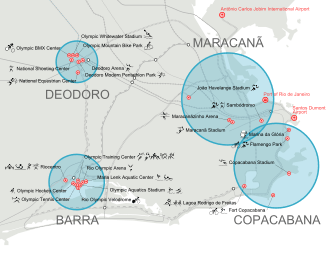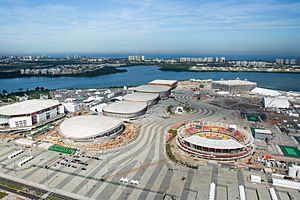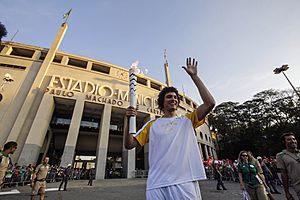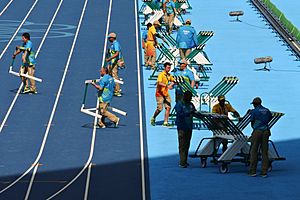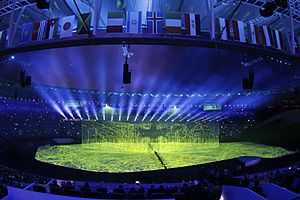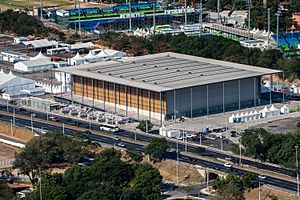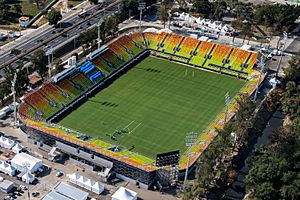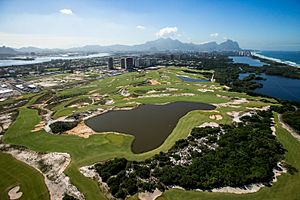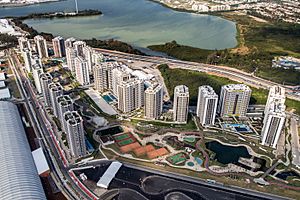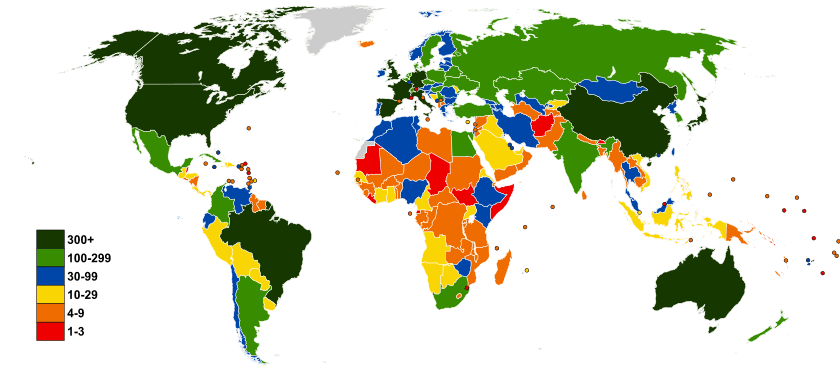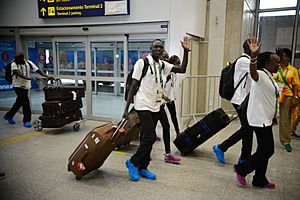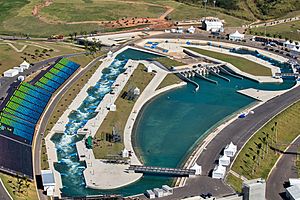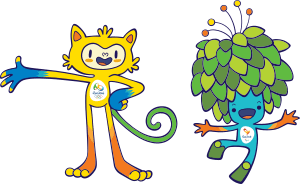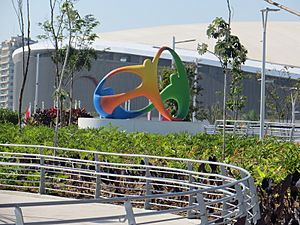2016 Summer Olympics facts for kids
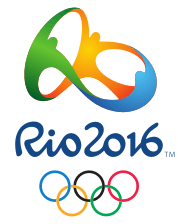 |
|||
| Host city | Rio de Janeiro, Brazil | ||
|---|---|---|---|
| Motto | A new world (Portuguese: Um mundo novo) |
||
| Nations | 207 | ||
| Athletes | 11,238 | ||
| Events | 306 in 28 sports (41 disciplines) | ||
| Opening | 5 August | ||
| Closing | 21 August | ||
| Opened by |
Vice President Michel Temer, as acting president
|
||
| Cauldron |
Vanderlei Cordeiro de Lima
|
||
| Stadium | Maracanã | ||
| Summer | |||
|
|||
| Winter | |||
|
|||
The 2016 Summer Olympics, also known as Rio 2016, was a huge international sports event. It took place from August 5 to August 21, 2016, in Rio de Janeiro, Brazil. Some events started a bit earlier, on August 3. Rio was chosen to host the Games on October 2, 2009, in Copenhagen, Denmark.
More than 11,000 athletes from 207 countries competed in the 2016 Games. For the first time, athletes from Kosovo, South Sudan, and a special Refugee Olympic Team took part. There were 306 sets of medals given out across 28 Olympic sports. New sports like rugby sevens and golf were added for these Games. The events happened at 33 places in Rio and five other Brazilian cities: São Paulo, Belo Horizonte, Salvador, Brasília, and Manaus.
These Olympics were special for many reasons. They were the first Olympic Games ever held in South America. They were also the first in a country where Portuguese is spoken. It was the first Summer Olympics held during the host country's winter season. Also, it was the first time since 1968 that the Games were in Latin America. And it was the first time since 2000 that they were held in the Southern Hemisphere.
The United States won the most medals overall, with 121. They also won the most gold medals, with 46. The U.S. team even won its 1,000th Summer Olympic gold medal ever! Great Britain came in second place. China finished third. Host country Brazil won seven gold medals, which was their best performance ever. Several countries won their first-ever gold medals, including Bahrain, Fiji, Ivory Coast, Jordan, Kosovo, Puerto Rico, Singapore, Tajikistan, and Vietnam. The Independent Olympic Athletes from Kuwait also won a gold medal.
Getting Ready for the Games
Planning for the Olympics is a huge job. Sometimes, people in charge change. For example, Roderlei Generali, the chief operating officer for the Rio Games, left his job in 2011. This happened just a year after he started.
Olympic Venues and Buildings
The Olympic events took place at many different locations. Some were existing places, nine new venues were built, and seven were temporary.
The venues were grouped into four main areas: Barra, Copacabana, Deodoro, and Maracanã. This made it easier for athletes to get to their events. Many athletes could reach their venues in less than 10 minutes. About 75% could get there in under 25 minutes. Eight of the 34 competition venues were improved permanently. Seven were temporary, and nine were built to be used long after the Games.
The biggest venue was the Maracanã Stadium, which could hold 74,738 people. It was used for the opening and closing ceremonies and the football finals. The second largest was the Estádio Olímpico João Havelange, which hosted track and field events. The athletes' village was the biggest in Olympic history. It had about 80,000 chairs, 70,000 tables, 29,000 mattresses, and 6,000 televisions.
Barra Olympic Park Venues
The Barra Olympic Park was a group of nine sports venues in Barra da Tijuca. This area is in the west part of Rio de Janeiro. The land used to be a Formula One race track.
The nine venues inside the Olympic Park were:
- Carioca Arena 1 for basketball
- Carioca Arena 2 for wrestling and judo
- Carioca Arena 3 for fencing and taekwondo
- Future Arena for handball
- Maria Lenk Aquatics Centre for diving, synchronized swimming, and water polo
- Olympic Aquatics Stadium for swimming and water polo play-offs
- Olympic Tennis Centre for tennis
- Rio Olympic Arena for gymnastics
- Rio Olympic Velodrome for track cycling
Olympic Medals
The medals for the Rio 2016 Games were made by the Brazilian Mint. The design was shown on June 15, 2016. These medals were made to be good for the environment. The silver and bronze medals contained 30% recycled materials. The gold medals were made using gold that was mined in a way that protected nature, without using harmful mercury.
The front of the medals showed a wreath design. The back showed Nike, the Greek goddess of victory, which is a long-standing Olympic tradition. Each medal came in a special wooden box. Medal winners also received a trophy shaped like the Games' logo.
After the Games, some medals showed damage like black spots or flaking. Rio officials offered to replace these medals. About 6% to 7% of all medals had problems.
Olympic Torch Relay
The Olympic flame was lit on April 21, 2016, at the Temple of Hera in Olympia. This is the traditional start of the torch relay in Greece. The flame was then given to the Brazilian organizers in Athens on April 27. The torch made a quick stop in Switzerland to visit the Olympic Museum.
The torch relay started its journey around Brazil on May 3 in the capital city, Brasília. The flame traveled to over 300 Brazilian cities, including all 26 state capitals. The relay ended in Rio de Janeiro on August 5. The flame was then used to light the Olympic cauldron during the opening ceremony.
The Games Begin
Opening Ceremony
The opening ceremony happened at Maracanã Stadium on August 5, 2016. It was directed by Fernando Meirelles, Daniela Thomas, and Andrucha Waddington. The ceremony showed off Brazilian history and culture. It also included a part about protecting the environment and preventing global warming. About 60,000 people were in the stadium, and an estimated three billion people watched it around the world.
During the ceremony, the first-ever Olympic Laurel award was given. This award honors people who have made big achievements in education, culture, and peace through sport. The award went to Kenyan athlete Kipchoge Keino. The Games were officially opened by the acting president of Brazil, Michel Temer.
The Olympic cauldron was lit by long-distance runner Vanderlei Cordeiro de Lima. He won a bronze medal in the men's marathon at the 2004 Olympics. He also received a special medal for sportsmanship after being attacked by a spectator during his race. Brazilian football legend Pelé was originally expected to light the cauldron, but he couldn't due to health issues.
After the main ceremony, a public cauldron was lit outside the Candelária Church. It was lit by Jorge Gomes, a 14-year-old Brazilian athlete who overcame poverty to become a runner.
Sports at Rio 2016
The 2016 Summer Olympics featured 28 sports with 306 events. Here are the sports that were part of the Games:
| 2016 Summer Olympic Sports Programme | ||||
|---|---|---|---|---|
|
New Sports Added
In 2008, the International Olympic Committee (IOC) looked for two new sports to add. Many sports applied, including baseball, softball, karate, squash, golf, roller sports, and rugby union. After careful consideration, rugby sevens and golf were chosen to be part of the Rio 2016 Olympic program. Rugby had last been in the Olympics in 1924, and golf in 1904.
Participating Countries
All 205 National Olympic Committees (NOCs) sent at least one athlete to Rio. Germany, Great Britain, and the Netherlands were the first countries to qualify athletes. As the host nation, Brazil automatically entered athletes in some sports.
The 2016 Summer Olympics were the first Games where Kosovo and South Sudan could participate. Some countries, like Bulgaria and Russia, had their weightlifters banned due to past rule violations. Kuwait was also banned from participating as a country because of government interference in its Olympic committee.
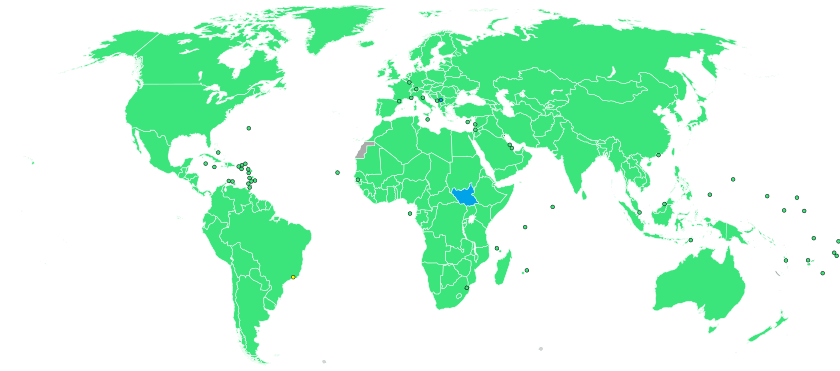
Blue = Participated for the first time in 2016.
Green = Had previously participated.
Yellow circle is host city (Rio de Janeiro)
Refugee Olympic Team
Because of global events, the IOC allowed athletes who were refugees to compete. They competed as Independent Olympians under the Olympic Flag. This was a new and important step. On March 2, 2016, the IOC created a special Refugee Olympic Team (ROT). Out of 43 possible refugee athletes, 10 were chosen to form this team.
Independent Athletes
Athletes from Kuwait competed under the Olympic Flag as Independent Olympic Athletes. This was because Kuwait's National Olympic Committee was suspended.
Russia faced issues with some of its athletes. The International Association of Athletics Federations (IAAF) had suspended Russia from international track and field events due to concerns about past rule violations. The IAAF said some Russian athletes could compete as "neutral" athletes if they proved they had not been involved in any issues. However, the IOC decided that Russian athletes would compete under the Russian flag.
National Houses
During the Games, many countries had special "national houses" in Rio. These were temporary places where supporters, athletes, and others could meet and celebrate.
| Nation | Location | Name |
|---|---|---|
| Africa House | Barra da Tijuca | Casa da África |
| Australia | Rio de Janeiro Stock Exchange Convention Center | Casa da Austrália |
| Austria | Botafogo | Casa da Áustria |
| Brazil | Gamboa | Casa do Brasil |
| Colombia | Centro | Casa da Colômbia |
| Czech Republic | Barra da Tijuca | Casa da República Tcheca |
| Denmark | Ipanema | Pavilhão Dinamarquês |
| Finland | Centro | Casa da Finlândia |
| France | Lagoa | Clube da França |
| Germany | Leblon | Casa de Praia da Alemanha |
| Great Britain | Parque Lage, Jardim Botânico | Casa Olímpica da Grã-Bretanha |
| Hungary | Gávea | Casa da Hungria |
| Jamaica | Gávea | Casa da Jamaica |
| Mexico | Centro | Casa do México |
| Netherlands | Lagoa | Holland Heineken House (Casa da Holanda) |
| Portugal | Centro | Casa de Portugal |
| PyeongChang 2018 | Copacabana Beach | Casa de PyeongChang 2018 |
| Qatar | Botafogo | Bayt Quatar |
| Russia | Copacabana | Casa do Time Olímpico do Rússia |
| Slovakia | Barra da Tijuca | Casa Eslovaca |
| Tokyo 2020 | Barra da Tijuca | Casa de Tóquio 2020 |
| Tokyo Metropolitan Government | Paço Imperial | Casa do Governo Metropolitano de Tóquio |
Records Set at Rio 2016
Many new records were set during the 2016 Summer Olympics. Twenty-seven world records and ninety-one Olympic records were broken. These records happened in sports like archery, athletics, canoeing, cycling, modern pentathlon, rowing, shooting, swimming, and weightlifting.
Medal Winners
The United States won the most gold medals, followed by Great Britain and China. Host nation Brazil finished in 13th place with a total of 19 medals (7 gold, 6 silver, and 6 bronze).
* Host nation (Host nation (Brazil))
| Rank | NOC | Gold | Silver | Bronze | Total |
|---|---|---|---|---|---|
| 1 | 46 | 37 | 38 | 121 | |
| 2 | 27 | 23 | 17 | 67 | |
| 3 | 26 | 18 | 26 | 70 | |
| 4 | 19 | 17 | 20 | 56 | |
| 5 | 17 | 10 | 15 | 42 | |
| 6 | 12 | 8 | 21 | 41 | |
| 7 | 10 | 18 | 14 | 42 | |
| 8 | 9 | 3 | 9 | 21 | |
| 9 | 8 | 12 | 8 | 28 | |
| 10 | 8 | 11 | 10 | 29 | |
| 11–86 | Remaining NOCs | 125 | 150 | 181 | 456 |
| Totals (86 entries) | 307 | 307 | 359 | 973 | |
Podium Sweeps
A "podium sweep" happens when athletes from the same country win all three medals (gold, silver, and bronze) in one event. At Rio 2016, this happened once:
| Date | Sport | Event | NOC | Gold | Silver | Bronze |
|---|---|---|---|---|---|---|
| 17 August | Athletics | Women's 100-meter hurdles | Brianna Rollins | Nia Ali | Kristi Castlin |
Closing Ceremony
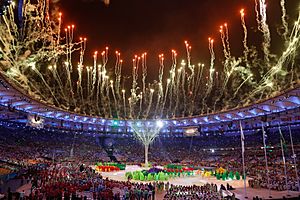
The closing ceremony of the 2016 Summer Olympics was held on August 21, 2016, at the Maracanã Stadium. The ceremony included cultural performances from Brazil and Japan, as Tokyo would host the next Summer Olympics. IOC president Thomas Bach officially declared the Games closed.
The creative director for the ceremony was Rosa Magalhães. Despite heavy rain, the ceremony began with dancers showing famous Rio landmarks. Singer Martinho da Vila performed a classic Brazilian song. Another part featured singer Roberta Sá honoring Carmen Miranda, a famous Brazilian entertainer. The Parade of Flags followed, with a choir of 27 children singing the Brazilian national anthem.
Cost of the Games
The Rio 2016 Summer Olympics cost about US$4.6 billion. This amount included money spent on running the Games, like technology, transportation, and security. It also covered the costs of building new venues, the Olympic village, and media centers.
Marketing and Symbols
Mascots
The official mascots for the 2016 Summer Olympics and Paralympics were shown on November 24, 2014. They were created by a company called Birdo. The Olympic mascot, Vinicius, was named after musician Vinicius de Moraes. Vinicius represents Brazilian wildlife and looks like a mix of cats, monkeys, and birds. The mascots were created to show the joy Brazilians felt when Rio was chosen to host the Games.
The names of the mascots were chosen by a public vote. The names Vinicius and Tom won with 44% of the votes. These names honor the writers of the famous song "The Girl from Ipanema". At the Olympic wrestling events, coaches would throw plush dolls of Vinicius into the ring if they wanted to challenge a referee's decision.
Olympic Emblem
The official logo for the 2016 Summer Olympics was designed by a Brazilian company called Tatíl Design. It was revealed on December 31, 2010. The emblem shows three figures holding hands and feet, forming a shape that looks like Sugarloaf Mountain. The designer, Fred Gelli, said it was the first 3D logo in Olympic history.
Some people thought the logo looked like a painting by Henri Matisse called Dance. There were also claims that the logo was copied from the Telluride Foundation's logo, which also shows figures linked together. However, the designer defended the logo, saying that the idea of linked figures is an old concept found in many cultures.
Images for kids
-
Mauá Square, with the Museum of Tomorrow, designed by Santiago Calatrava, and the light rail.
-
Olympic Stadium Rio de Janeiro, RJ
-
Mineirão Belo Horizonte, MG
See also
 In Spanish: Juegos Olímpicos de Río de Janeiro 2016 para niños
In Spanish: Juegos Olímpicos de Río de Janeiro 2016 para niños


